Abstract
Rural electrification is a fundamental step towards achieving universal access to electricity by 2030. On-grid rural electrification remains a costly proposition, therefore the need to consider off-grid renewable energy solutions is inevitable. However, the critical issue pertaining to local power generation through renewable energy is the absence of area-specific production capacity and economic viability data for the different renewable energy technologies. This paper addresses this issue for Pakistan’s Balochistan province by assessing the area’s potential and economic feasibility of using solar PV for rural electrification. The results suggest that the Balochistan province has the best solar irradiance value in the world. Furthermore, optimal tilt angles calculated for respective regions can significantly increase solar energy yield. The economic feasibility study, carried out for solar PV systems, reveals that the electricity generated using solar PV costs Rs. 7.98 per kWh and is considerably cheaper than conventional electricity, which costs approximately Rs. 20.79 per kWh. Similarly, solar PV systems could mitigate 126,000 metric tons of CO2 annually if 100% of the unelectrified households adopted solar PV systems. Based on these research findings, this paper proposes a policy that would serve as a guideline for the government to extend solar PV-based off-grid rural electrification projects in Balochistan as well as on a national scale.
1. Introduction
Electricity is the key ingredient for the social and economic development of human beings. It is one of the greatest inventions of mankind and has altered countless human lives in unimaginable ways, yet around 1.1 billion people still live without this important blessing that science has provided [1]. Most of Earth’s current unelectrified population live in the rural areas of developing countries in Sub-Saharan Africa and South Asia [2]. Like other developing countries, Pakistan also has a large population without electricity access. The country is in its transition phase; economic development has led to increased electricity demand. The current electricity demand of the country is 25,000 MW and is projected to increase to 40,000 MW in 2030 [3]. However, the electricity supply remains between 18,000 and 20,000 MW causing an electricity deficit of 5000–7000 MW [4]. This intense electricity shortage results in power outages for 8–10 h in urban areas while the rural areas face load-shedding up-to 18 h a day [5]. The situation is even worse in the rural areas of Balochistan province where electricity remains unavailable for days.
Despite being rich in energy sources such as oil, coal, gas, and renewable energy, Balochistan has been denied sufficient access to electricity. Studies reveal that there are three major reasons for low electrification in the province. First, approximately 85% of the provincial population lives in rural areas and about 90% of villages are unelectrified [6]. These villages are scattered over large and distant areas. Connecting such areas to the grid is expensive and uneconomic. Second, the electricity demand for houses in rural areas is very low—varying from 50 to 100 W [7]. Lighting is the only requirement of houses in rural areas, which are generally one roomed huts with walls and roofs built of mud and straw. Extending transmission lines for such a small load is, therefore, a costly proposition and policymakers foresee little possibility of grid connection in the near future. Similarly, diesel generators do not offer an economic alternative because of the difficulty and cost of transporting fuel to remote areas. Last but not least, investors are reluctant to invest in rural Balochistan due to its remoteness, lack of infrastructural facilities available in the province, and unavailability of area-specific energy-related data.
Given these factors, solar energy represents the best opportunity for off-grid power generation in the rural areas of Balochistan as the province receives large amounts of solar irradiance on its vast lands [8]. The World Bank, in its solar energy assessment of Pakistan, reported that the entire Balochistan is rich in solar energy and has the highest average sunshine hours in the world [9]. The report further states that the northern parts of the province, with peak direct normal irradiance (DNI) value of 2700 kWh/m2, are the most desirable for solar energy generation. Additionally, the report compares these values with those received in the Sinai Peninsula, which is one of the top solar radiance receiving location in the world. Similarly, Sustainability Advocacy suggested that the solar photovoltaic (PV) is the best choice for electrification due to the high temperature in Pakistan. Also, Sustainability Advocacy argued that instead of extending grid lines to remote areas, giving a solar panel to each house is a more economic approach to empowering the socio-economic condition of Balochistan’s rural population [7]. Further, the Asian Development Bank believes that the off-grid power is the only solution to electrifying the remote areas in Pakistan [10].
Numerous studies also support the deployment of solar PVs for off-grid rural electrification because solar PVs are modular, have less weight, and can be installed easily [11,12,13]. Also, solar PV avoids fuel transportation, reducing costs and making the project simpler by utilizing on-site resources. Mishra and Behera [14] found that the adaptation of solar PV system contributes to the socio-economic activities in rural areas and improves the living standards of households, especially of women in those areas. Sandwell et al. [15] showed in their study that the solar PV is a sustainable source of rural electrification because of its attributes of local environmental protection, net energy ratio, and life cycle cost. PV systems are emission-free energy systems and have an insignificant impact on greenhouse gas emissions. Hosenuzzaman et al. [16] reviewed the environmental benefits of solar PV and summarized that PV based electrification provides extensive environmental benefits as compared to other energy sources. Solar PV has a positive impact on the environment (i.e., it helps to reduce CO2 emission, generates no noise, and has positive health benefits). Also, the use of solar PV lighting eliminates the need to use kerosene-lights, reducing indoor air pollution. Obeng et al. [17] showed that solar PV lighting reduced the chances of household members being affected by indoor air pollution from kerosene-lights by 50% in rural areas of Ghana. Multiple studies [18,19,20,21] show that solar PV is the best application for off-grid rural electrification and is also economically feasible. However, there are many challenges in the implementation of the solar PV projects in rural areas due to area-specific circumstantial differences, which makes experience-sharing crucial.
Similarly, to achieve universal access to electricity, separate policies for off-grid rural electrification should be devised. More research is needed to assess the area-specific potential of renewable energy sources and analyze economic feasibility for utilizing renewable energy. To the best of our knowledge, no such study has been carried out in the past for Balochistan. Therefore, this study attempts to fill this research gap. Under this study, the Balochistan province is divided into six regions, and the potential of solar energy for power generation is assessed. This paper also analyzes the economic viability of solar PV systems in rural areas and estimates the emissions to be mitigated. This study shall be helpful for guiding policy on rural electrification in Balochistan and encouraging reluctant investors to invest in the solar PV system application by providing them detailed techno-economic analysis. The major contribution of this study is that it will pave the way for increased rural electrification in Balochistan.
2. Background of Electrification in Balochistan
2.1. Current Electrification Status
Balochistan is the largest province of Pakistan in terms of area, and it is the least developed province, where a majority of the population lack basic facilities. According to the Economic Survey of Pakistan 2016–2017, Balochistan has the highest poverty rate and lowest literacy rate in Pakistan [22]. The location of Balochistan holds strategic importance due to its long coastal line as shown in Figure 1. The port city of Gwadar provides the shortest route to the Middle East and Central Asia. Due to this significance, Gwadar has attracted foreign investment and many ongoing development projects [23]. Project development has caused Balochistan’s demand for electricity to increase over the last decade.
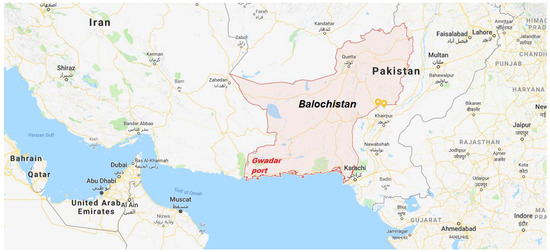
Figure 1.
Map of Balochistan province (source: Google maps).
The region’s current electricity demand is approximately 1650 MW, but supply is limited to 400 to 600 MW. The massive shortage of electricity results in power outages of 10–12 h in urban areas. The situation of power outages is worse in rural areas, where approximately 85% of total 13.16 million people of Balochistan reside and electricity in rural areas is only available for 3–4 h in a day [24]. Most villages consist of 20 houses and have a population of around 100 people. Power consumption per house in those rural areas is considerably less as compared to the other parts of the country however because of long HT and LT transmission lines, the cost per kWh is high. The current electricity consumption pattern in the province can be broken down as follows: domestic (82%), commercial (12%) and industrial (0.53%). According to the 2014–2015 fiscal report of the Quetta Electric Supply Company (QESCO)—the only company supplying electricity in the province—the demand for electricity is expected to increase by 8%, reaching 2500 MW, at the end of 2019 [25].
Balochistan has a total installed capacity of 2422 MW, which is generated through gas-based thermal. Most of the electricity generated in Balochistan is transmitted to other provinces for their utilization. QESCO purchases electricity from two independent power producers, Uch Power and Habibullah Coastal Power, and from public sector generation company viz. Guddu Power Station. Iran also supplies power to areas close to its borders, such as Mashkail, Taftan, and Gwadar. Maskhail and Taftan receive 2 MW each, with 20 kV transmission line. Gwadar, however, receives 70 MW with 132 kV transmission line. Moreover, a 35 MW gas-based power plant in Quetta that is connected to the national grid, two steam-based power plants at Pasni (17 MW) and Panjgoor (38 MW) are used to meet balance demand. Furthermore, there are some captive power plants that meet industrial power requirement in Balochistan [26].
The federal government’s recent decision to reduce countrywide load shedding will not produce any positive results for Balochistan because the existing transmission and distribution network of the province is incapable of supplying any load beyond 600 MW. The National Transmission and Dispatch Company (NTDC) has one 500 kV transmission line of 27 km circuit length, however no grid station of 500 kV exists in the province. Similarly, there are only three grid stations of 220 kV, and each has 220 kV transmission line of 768 km circuit length. The situation is the same at 132 kV, 66 kV, and 33 kV networks of NTDC and in-service substations of QESCO [26].
Despite its strategic importance, Balochistan has been denied sufficient and reliable access to electricity and gas for decades. However, the province is rich in various energy resources such as oil, gas, coal and renewable energy. In a population of 13.10 million people, only 548,980 consumers are registered with QESCO [25]. As far as power supply to registered consumers is concerned, it is neither sufficient nor reliable. Similarly, the consumption rate natural gas is extremely low—only 3% of the provincial population consumes natural gas because of the limited supply network [27], which persists despite the fact that the huge natural gas reserves of Balochistan have been fueling the country’s economy since the 1950s. In the absence of electricity and gas, people predominantly use kerosene and candles for lighting, and firewood, agricultural waste and animal dung for cooking and heating purposes.
The government of Balochistan has not changed its policy approach despite the increasing demand for electricity. The Balochistan Power Generation Policy of 2007 neglects the importance of developing renewable energy. Solar, wind, micro-hydro, biomass and geothermal energy are among the various resources for alternative energy production in Balochistan. However, due to lack of interest shown by governments in the past, harnessing these abundant renewable resources is insignificant [28]. Investors have remained reluctant to invest in Balochistan. Poor law and order, remoteness of the area, low return on investment, and lack of infrastructure and communication services are some of the major factors impeding private investment. Furthermore, no tangible progress has been made on a 300 MW solar power park to be connected to the national grid near Quetta by a South Korean company at an investment of $700 million. The agreement for building this solar park was signed between CK Solar of Korea and the government of Balochistan in December 2013 [24].
2.2. Progress of Solar PV in Rural Electrification
Solar PV use is not an entirely new phenomenon for Pakistan. In the 1980s, Pakistan installed solar PVs of 450 kWh. However, they proved unsuccessful due to lack of technical and managerial oversight [29]. Subsequently, Pakistan’s solar energy outlook remained bleak until the creation of the Alternative Energy Development Board (AEDB) in 2006. AEDB was created to oversee and promote the development of renewable energy in Pakistan. Recently AEDB planned to electrify 6968 and 906 houses with solar PVs in remote villages of Balochistan and Sindh provinces, respectively, in the next few years [30]. The Pakistan Commission of Renewable Energy Technologies (PCRET) is the other major institution tasked with promoting renewable energy technologies in Pakistan. Figure 2 shows an organogram of the electricity sector with institutions that oversee and promote the development of renewable energy across the country. Moreover, there was a significant improvement in solar energy framework after the government realized the importance of solar energy for saving the environment and uplifting socio-economic condition of people residing in remote areas.

Figure 2.
Organogram of the electricity sector in Pakistan [31].
The current Pakistani market is favorable for solar energy technologies because of various potential factors such as high irradiance, organized regulatory framework, incentives and even financing are available in the country [32]. Recently the government of Pakistan has introduced lucrative incentives for solar energy development in the country. Investors are offered financial and fiscal benefits that attract them to this market. The federal government is spending Rs. 23 billion to replace 30,000 conventional tube wells with solar tube wells in Balochistan, which shall save federal government Rs. 23 billion from conventional tube well subsidies [33].
Moreover, provincial governments are also keenly facilitating solar power development in respective provinces. Punjab, the largest province of Pakistan in terms of population, plans to shift about 11,000 schools in rural areas of Southern Punjab to solar power. The provincial government of Khyber Pakhtun Khuwa (KPK) province has invested Rs. 400 million to provide solar PVs to 5800 off-grid households in 200 villages. The provincial government of KPK will provide 90% of solar PV cost, and households will shoulder the remaining 10%. In addition, each household will be given a 200-watt solar panel, two batteries, and accessories to run a pedestal fan, a ceiling fan, two mobile charging slots and three LED lights [34]. Furthermore, a number of non-profit and for-profit organizations are working in unserved rural areas to install solar PVs. Some for-profit organizations have adopted schemes of pay-as-you-go to disseminate solar products among consumers to provide them with more flexibility for payment and use. Solar mobile chargers and rechargeable lights among other solar products are particularly of major interest in rural areas.
Nonetheless, there is a long way to go as approximately 80 million people, and 40,000 villages do not have access to electricity in Pakistan. As per [35] Pakistan has 2300 GW solar energy potential, and only an inconsiderable amount has been tapped. The majority of electricity is produced using fossil fuels (60.17%), which are imported and therefore burdensome to the economy. Hydropower is the second major input for electricity production with a share of (33.87%) followed by nuclear power (5.15%). Only a meager amount of renewable energy resources are used in the power mix of Pakistan with wind (0.47%), biogas (0.32%) and solar (0.03%) totaling less than 1% [36].
2.3. Issues for Rural Electrification with Solar PV in Pakistan
Solar PV is the best choice for electrification in off-grid rural areas due to its easy installation, cost-effectiveness, and environmental benefits, however, its deployment for rural electrification in Pakistan is considerably low at a time when, according to the NEPRA State of Industry 2016 Report, 40,000 villages in Pakistan do not have access to electricity [36]. Studies on successful rural electrification suggest that strong coordination among institutes is vital to deal with the issues hampering rural electrification projects [37]. However, Pakistan has an unfortunate history of poor institutional coordination, and before the establishment of AEDB in 2006, no institute was responsible for the planning and developing renewable energy projects in Pakistan. However, after the establishment of AEDB and PCRET, institutional coordination between AEDB and PCRET, along with other major stakeholders and ministries remains poor [38].
Government departments lack the capacity to plan and develop innovative rural electrification strategies through solar PVs. Deficient government policies, therefore, pose a major impediment to solar PV based rural electrification. The government of Balochistan’s current policy, i.e., Balochistan Power Generation Policy 2007, is meant to reduce electricity shortages in the province [24]. The policy is overly reliant on fossil fuels and fails to incorporate the enormous potential of solar energy. Moreover, the existing supporting legislation for solar PV application includes only tax exemptions or reductions, which do not bring any significant incentive for low-income rural communities. In addition, the lack of renewable energy data and demarcation or mapping of unelectrified villages make investors reluctant to invest in those areas. The absence of demarcation creates uncertainty for private investors considering investment in those areas, who need key characteristics of targeted areas.
The high upfront cost of solar PV also serves as a potential bottleneck for widespread solar PV usage in Pakistan. Though solar PV costs continue to fall, the cost that prevails in the Pakistani market is considerably higher when compared to developed countries [39]. Moreover, a lack of subsidies for solar PV systems and the absence of a pricing policy that incorporates the economic cost of its environmental benefits impede the promotion of a robust solar PV system in Pakistan. During the finance bill 2014–15, the government of Pakistan imposed a 32% tariff on import of solar PVs. The tariff significantly slowed down solar PV progress. Due to this, the government reversed its decision. However, 50% and 45% tariffs still exist on importing solar batteries and solar hybrid inverters, respectively. Similarly, the government does not provide any incentives to households on the deployment of solar PVs. Moreover, there is a lack of governmental loans for both customers and investors [40].
The German Solar Association found that there is little awareness among the public regarding the variety of solar PV systems available on the Pakistani market [41]. Since no standardization or quality tests are instituted in the country, low-quality solar PV systems are being imported and sold in the market, which diminish the reputation of solar technologies. The local solar PV industry is in its infancy and does not meet the qualitative nor quantitative demands of the market. Moreover, there is a shortage of the trained technicians needed to install and maintain solar PV systems, particularly in rural areas of Pakistan.
3. Methodology
3.1. Solar Energy Potential on Horizontal Surface and Finding Optimal Tilt Angle
Solar radiation is normally measured on a horizontal surface. Solar panels receiving direct radiation have high energy yield. Therefore, solar panels are often tilted to increase the irradiance incident. To find out the optimum tilt angle is thus necessary to maximize solar yield [42]. One of the best ways to increase the solar yield is by applying an active solar tracker on solar panels. Active solar trackers keep changing the orientation of solar panels to receive maximum energy during the day. However, active solar trackers come with a high cost and consume extra energy for tracking [43]. In addition, solar trackers are complex to be used in rural areas. Therefore, it may be more feasible to change the tilt angle of PV panel manually than applying solar trackers. Several methods are used to calculate the optimum tilt angle for maximizing the irradiance incident from of horizontal radiation [44,45,46]. Here, a titled surface receives a direct beam, some radiation is absorbed and some is diffused, the rest is rays reflected off the ground, thus the global irradiance incident on a tilted surface has following three components:
where is direct beam, is diffuse radiation, and is reflected rays components of solar energy on a tilted surface.
Let be the ratio between the average daily direct beam on a tilted surface and the average daily direct beam on a horizontal surface, then can be rewritten as:
is a pure geometric parameter, therefore it’s value depends upon horizontal tilt, declination angle, surface azimuth and latitude. The widely used Liu and Jordan model [47] is used here for determining :
where is the latitude, is the tilt angle, and are sunshine hours and declining angles.
For simplicity, we assume an isotropic distribution of diffused radiation. Thus the diffused area depends upon the diffused radiation on the horizontal surface and the horizontal tilt angle β:
The solar energy of the reflected rays depends upon the ability of the ground to reflect, a property which is known as albedo factor ρ. The range of albedo varies from 0.1 (asphalt) to 0.9 (snow). Thus the reflected beam can be calculated as:
3.2. Economic Feasibility of Solar PV System
3.2.1. Sizing of Solar PV and Battery Storage
A typical off-grid PV system includes a PV module, system controller, battery storage, DC to AC inverter and load or demand. PV panels receive solar energy and pass it to the system controller after converting it to DC. The DC then supplies the load through a DC-AC inverter. The amount of electricity generated through a PV system is heavily dependent on the amount of solar radiance received in the surrounding area. However, other factors need to be considered, such as panel efficiency, optimal tilt angle and regular maintenance [48]. Furthermore, it is important to account for losses incurred during DC to AC conversion. There are several models to predict solar electricity yield on a tilted PV from horizontal irradiance. The annual solar irradiance data on a horizontal surface has been taken from NASA’s database, and the potential of electricity generated annually by solar PVs, (kWh) is calculated using Equation (6) [49]:
where, is the area of the panel, is its efficiency, is the mean annual amount of solar radiation received on a tilted panel, and is the performance ratio accounting for the losses incurred. is calculated using the equation below [50]:
where is the referenced efficiency of the solar panel, which is conventionally provided by the manufacturer, is the temperature coefficient of solar panels, is the ambient temperature and is the referenced temperature of solar panels, and are the nominal operating temperature and ambient nominal operating temperature of solar panel cell, is the solar radiation for the nominal operating temperature of the solar panel cell test.
A critical task in designing any PV system is to estimate the load that the system will have to support., Demand can be calculated by compiling a list of necessary appliances, their watt ratings, and the number of operating hours in a tabulated form and summing up watt-hours per household, and multiplying the figure retrieved by number of households. As shown in Table 1, the estimated load of one household in rural Balochistan is approximately 454 W, containing two LED lights, one ceiling fan, one pedestal fan, and two mobile charging slots.

Table 1.
Estimated load requirement of a rural household.
The total electricity generated at the front end of PV and the total electricity demanded is given by:
Solar energy can only be utilized in the daytime when the sun is available. To ensure the supply of electricity during night hours, an electricity storage technology is required. Most of rural Balochistan is off-grid, therefore battery storage is needed at an additional cost. Battery storage is the most effective technique used to store solar electricity for use during hours when the sun is unavailable, i.e., nighttime and cloudy weather. If generated electricity is higher than the electricity demand, then there will be an electricity excess, i.e., and the extra electricity will be saved in the battery. If the electricity demanded is greater than electricity generated i.e., then the PV system is said to be inadequate to meet the load at a specific time. The amount of electricity needed to be stored in a battery annually is thus given by:
where is excess electricity, is deficit electricity and is the efficiency of battery. Meanwhile, the daily storage capacity of battery is calculated as:
3.2.2. Levelized Cost of Electricity
Levelized cost of electricity (LCE) is the most common metric used to compare the relative cost of electricity generated by various sources and technologies. It ranks multiple options based on their cost-effectiveness. In our case, we compared solar PV with electricity generated through the conventional grid to determine the cost-effectiveness of both alternatives. In order to compare alternative technologies, the estimated levelized cost per kWh of electricity is calculated using the simple formula, given below [51]:
where, is the initial cost of investment in year i, is the maintenance cost in year i, is the fuel cost in year i, is the amount of electricity generated in kWh in year i, r is the discounted rate, and n represents the operational lifespan of the technology.
3.2.3. Life-Cycle Assessment of Solar PV Installation
Life-cycle assessment (LCA) is an important tool to investigate the environmental impacts of a product from cradle to grave. LCA is globally accepted to be used in wider fields including solar PV systems and we can find numerous studies which have performed LCA to assess the environmental impacts of solar PV systems. For instance, Li et al. presented a LCA to identify the environmental impacts of a low-concentration PV system in China [52]. Akinyele et al. conducted a life cycle impact assessment in terms of the life-cycle emission rate for six different locations in Nigeria [53]. Eskew et al. used LCA to evaluate the environmental burdens created by a rooftop solar PV installed on a university campus in Bangkok, Thailand [54].
The life-cycle stages of solar PV from raw material acquisition to disposal are given in Figure 3. The energy, material, and transport flows are often interlinked and emission may occur at different life-cycle stages. The principle of calculating LCA is simple. For each life-cycle stage, the amount of energy and materials used and the emissions associated is investigated to enable such evaluation, and conclusions are drawn for related environmental assessment. This study follows [52] to calculating the life-cycle greenhouse gases emission and the energy payback time (EPBT) of solar PV.
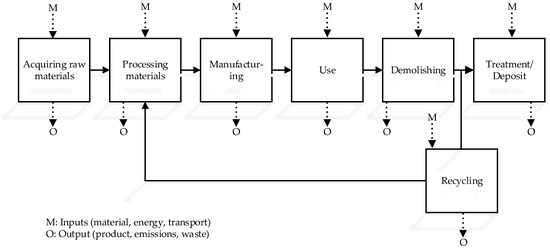
Figure 3.
Life-cycle stages of inputs and outputs for solar PV systems [55].
3.3. Emission Mitigation of Solar PV System
Solar PV systems generate clean energy from the sun and therefore help to reduce greenhouse gas emissions and eliminate the need for diesel generators in off-grid areas. Diesel generators are most commonly used in off-grid areas and possess high carbon intensity, however, renewable technologies such as solar PVs produce little or no emission during operation but may incur emission during manufacturing phase [56]. Therefore, replacing diesel generators with solar PVs can substantially mitigate CO2 emissions. The amount of CO2 emissions mitigated is calculated based on the amount of diesel fuel saved, , using solar PV and is expressed as follows:
where Fr is fuel required to generate 1 kWh of electricity using a diesel generator. The amount of CO2 abated using solar PV is measured in kg, thus, the formula to calculate CO2 emissions saved is as follows:
where is the carbon equivalent in kg emitted for generating 1 kWh of electricity using diesel generator and is the carbon equivalent in kg emitted for generating 1 kWh of electricity using solar PV.
4. Results and Discussion
The values of daily solar radiance received in all the six regions show the best potential to generate solar energy. Figure 4, Figure 5, Figure 6, Figure 7, Figure 8 and Figure 9 show the daily solar radiation received on a horizontal surface in each region. The average annual solar radiation received on a horizontal surface in all regions is shown in Figure 10. The Sibi region receives the highest annual solar radiation (5.79 kWh/m2) followed by the Quetta (5.72 kWh/m2), Naseerabad (5.67 kWh/m2), Zhob (5.60 kWh/m2), Kalat (5.51 kWh/m2), and Makran (5.18 kWh/m2) regions respectively.
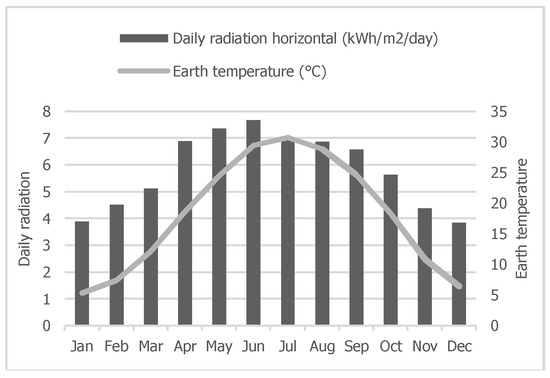
Figure 4.
Kalat region daily solar energy received.
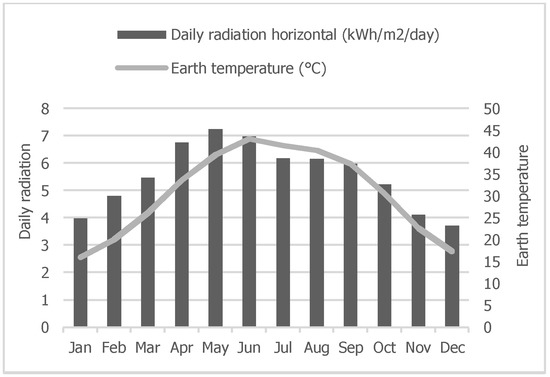
Figure 5.
Naseerabad region daily solar energy.
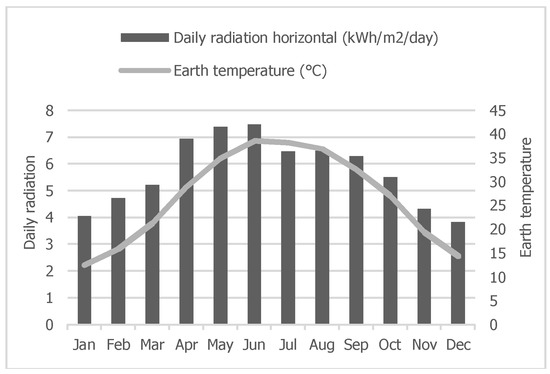
Figure 6.
Sibi region daily solar energy received.
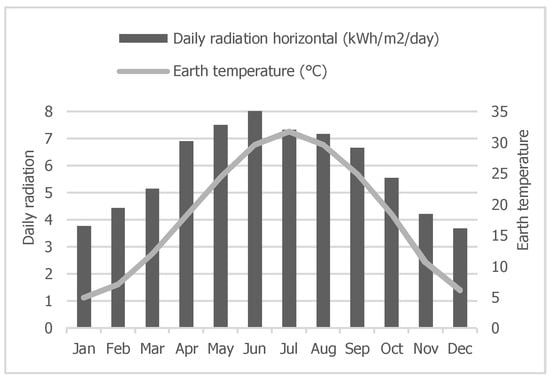
Figure 7.
Quetta region daily solar energy received.
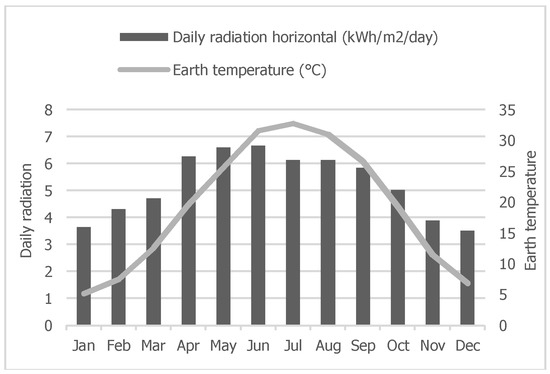
Figure 8.
Makran region daily solar energy received.
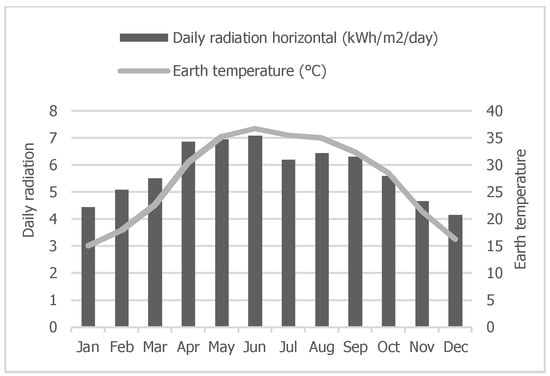
Figure 9.
Zhob region daily solar energy received.
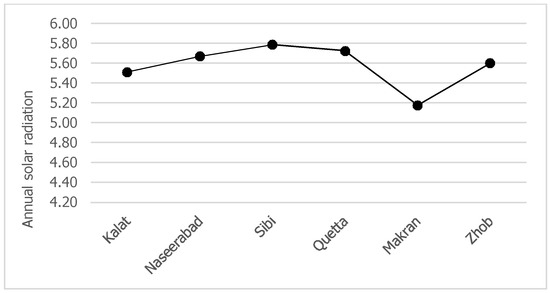
Figure 10.
Region-wise annual solar irradiance received on a horizontal surface.
4.1. Solar Radiation Received at the Optimal Tilt Angle
Based on Equations (1)–(5), the solar radiation received on a titled surface varying from 0 to 90 degrees is shown in Figure 11, Figure 12, Figure 13, Figure 14, Figure 15 and Figure 16 for each region. The results imply that a significant percentage of solar energy yield can be increased annually by setting solar PVs on the optimal tilt angle. Solar energy yield can be increased by 10.78% in Quetta at the optimal tilt angle of 29.2°. Likewise, 10.19% in Kalat on 28.1°, 9.87% in Makran on 28.3°, 12.55% in Zhob on 31.4°, 9.67% in Naseerabad on 28.0°, and 11.28% in the Sibi region on an optimal tilt angle of 30.3°.
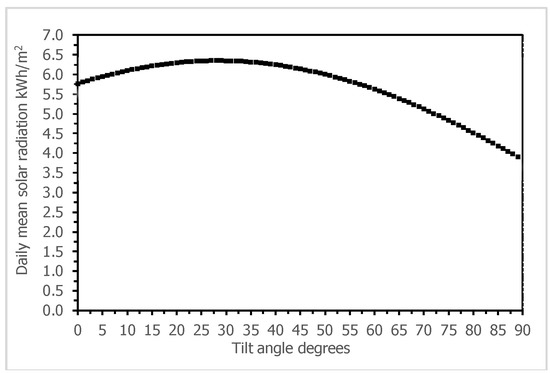
Figure 11.
Solar radiation on varying tilt in Kalat.
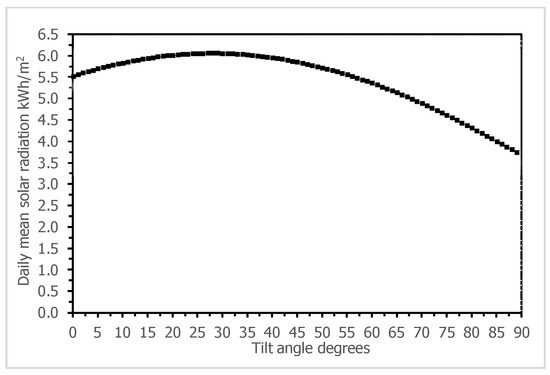
Figure 12.
Solar radiation on varying tilt in Naseerabad.

Figure 13.
Solar radiation on varying tilt in Sibi.
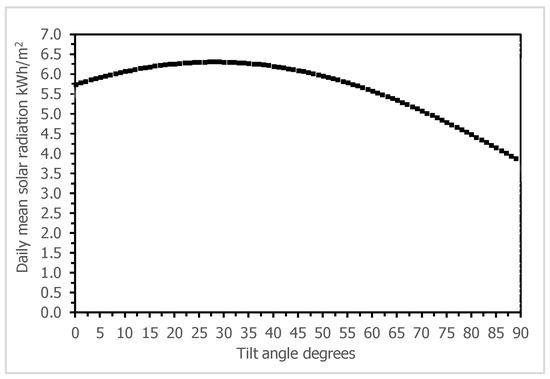
Figure 14.
Solar radiation on varying tilt in Quetta.
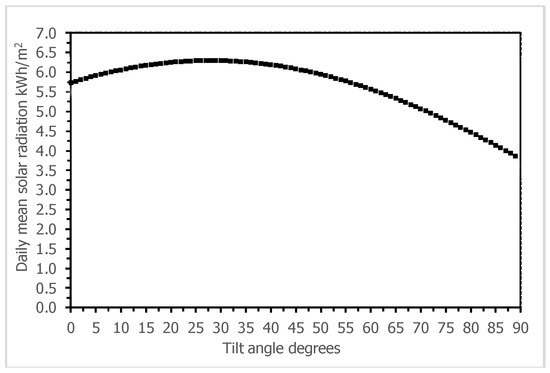
Figure 15.
Solar radiation on varying tilt in Makran.
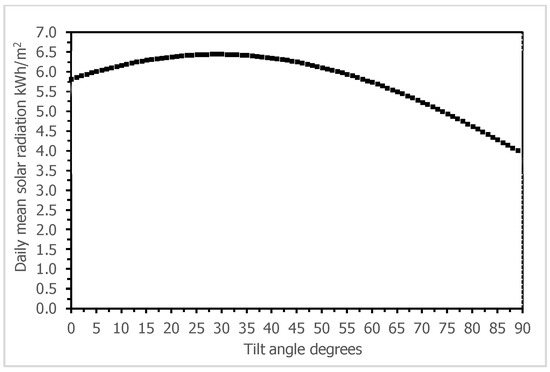
Figure 16.
Solar radiation on varying tilt in Zhob.
4.2. Economic Feasibility of Solar PV System
Simulation parameters for a proposed Solar PV system designed to meet the electricity requirement of rural household in Balochistan are given in Table 2, provided by [57,58]. Using Equations (6)–(10), we found a 200 W solar panel with a 140 Ah/12 V battery is suitable for the load of one household. A PV module area is 1.2 m2, while the maximum current and voltage are 7.61 A and 26.3 V. Furthermore, the conversion efficiency of a solar panel is 16%. Maximum electricity yield is generated from April to June in all selected sites, while a slight decline is observed from July to October due to monsoon season. Electricity production continues to decline through January and then starts to increase production in February.

Table 2.
Parameters used in simulation.
Based on cost specifications given in Table 2, the LCE of the proposed system, calculated using Equation (11), is PKR 7.98 per kWh whereas the cost of electricity from the conventional grid is PKR 20.79 [58]. Therefore, electricity generated through proposed PV system saves each household about PKR 12.81/kWh. The life-cycle assessment (LCA) has been conducted to assess the environmental impact occurred at each life-cycle stage. Results reveal that the most of impact is generated during manufacturing stage. The mounting structure and inverters also produce significant environmental burden and altogether these components are accounted for over 90% of climate change impact. The cumulative greenhouse gases emissions produced over the lifetime of solar PV system is 83 g CO2-eq/kWh. Whereas, the energy payback time is calculated as 2.5 years. Further, the payback time and greenhouse gases emissions are projected to decrease with technology advancement.
4.3. Emissions Mitigation of the Solar PV System
A typical 20 kW diesel generator generates 4 kWh of electricity using 1 L of diesel. To meet the annual demand of 165.71 kWh for the example household above, a diesel generator would consume 41.43 L of diesel annually. Based on Equation (13), the proposed PV system can mitigate 97.50 kg of CO2 per household every year. As per census 2017 [59], there are 1,301,212 households in rural Balochistan. If solar PV systems provided 100% of rural electrification, then approximately 126,869 metric tons of CO2 would be mitigated every year.
5. Conclusions and Policy Implication
Globally, solar PV is recognized as the best choice for local power generation in remote rural areas due to its easy transportation, installation, and maintenance. The initial steps, however, are to identify the area-specific potential of solar PV based electrification and the economic viability of applying solar PV systems in those areas. This paper covered all the six regions of Balochistan, i.e., Quetta, Sibi, Kalat, Naseerabad, Khuzdar, and Zhob, and developed a systematic method to assess the area-specific potential of solar PV. Initially, we assessed solar irradiance received on a horizontal surface. In order to maximize solar energy, we calculated the optimal tilt angles for all the respective regions and found that a significant percentage in energy output could be increased by setting solar panels on the optimal tilt angle. The optimal tilt angle is particularly useful because rural areas lack the technology needed for tracking the sun to maximize energy output. Solar trackers also come with an additional cost, making them unsuitable for rural areas. The best potential of solar energy was assessed in all regions and substantiates our claim that solar PVs is an attractive choice for electrification in Balochistan. We further analyzed if solar PV use is economically feasible. Our results revealed that solar PVs provide electricity at a considerably cheaper rate than conventional electricity. Coupled with economic viability, solar PVs also have the potential to mitigate approximately 126,869.45 metric tons of CO2 annually if 100% of rural households in Balochistan adopt solar PV systems.
Despite its abundant potential, solar PV is not currently being implemented for rural electrification in Balochistan due to various issues, which are covered in Section 2.3. Furthermore, solar PV systems provide the most reliable and effective source of generating electricity. The government of Pakistan can play a vital role in alleviating an energy crisis by encouraging rural communities to adopt solar PV systems. Moreover, the provincial government of Balochistan should not plan to electrify rural areas with grid-based conventional electricity: it would be a costly operation, and the current fragile economy of Pakistan is unable to afford it. Furthermore, Pakistan can utilize lessons learned from rural electrification programs implemented in India and Bangladesh [60,61], because both countries share key economic, social and geographic similarities with Pakistan. In conclusion, the following guidelines can be used to initiate effective solar PV rural electrification programs in Balochistan:
- Rural electrification programs should be initiated countrywide with key strategies and concrete action plans. The government should design supportive policies that provide incentives for both low-income communities and private investors.
- The availability of easy microcredit schemes may help rural communities to establish solar PV off-grid systems.
- Private investors need to be mobilized by formulating a legal framework for investment in rural electrification.
- Demarcation of off-grid rural areas accompanied by energy resource maps should be created by the appropriate institutes, i.e., AEDB and PCRET. The data should be made available online with clear resource mapping so that private investors may access it for their business purposes.
- The government should finance rural areas where private investors find it difficult to generate significant profits. However, priority should be given to private investors in areas where solar PV systems are economically viable.
- Strict adherence to quality control and quality assurance standards must be observed for solar PVs systems. Standard operating practices should be developed for manufacturers and importers of solar PVs to restrict the sale of substandard solar PVs.
- Local level capacity building to train workers in the skills in installing, operating and maintaining solar PVs should be a priority of the government. It is also important to develop the necessary infrastructure to establish last mile distribution of solar PVs and provide after-sales services.
- The upfront cost of solar PVs should be reduced by replacing CLFs with LED lamps.
- The government should give subsidies to relevant emerging microfinancing projects in rural areas. Non-profit organizations that assist rural communities in establishing solar PV systems should be given tax credits and subsidized equipment to encourage them to expand rural electrification projects.
Author Contributions
All the authors contributed to this work. S.A.A.S. developed concept and methodology of the study. S.A.A.S. and G.D.V. prepared original draft and finalized the manuscript. N.B.J. validated the results. A.N.L. and A.A.M. analyzed the model results. J.L.S. improved English language and style of manuscript.
Conflicts of Interest
The authors declare no conflict of interest.
References
- Warner, K.J.; Jones, G.A. A Population-Induced Renewable Energy Timeline in Nine World Regions. Energy Policy 2017, 101, 65–76. [Google Scholar] [CrossRef]
- International Energy Agency (IEA). World Energy Outlook 2017; International Energy Agency: Paris, France, 2017; pp. 1–15. [Google Scholar]
- Rehman, S.A.U.; Cai, Y.; Fazal, R.; Das Walasai, G.; Mirjat, N.H. An Integrated Modeling Approach for Forecasting Long-Term Energy Demand in Pakistan. Energies 2017, 10, 1868. [Google Scholar] [CrossRef]
- Das Valasai, G.; Uqaili, M.A.; Memon, H.U.R.; Samoo, S.R.; Mirjat, N.H.; Harijan, K. Overcoming Electricity Crisis in Pakistan: A Review of Sustainable Electricity Options. Renew. Sustain. Energy Rev. 2017, 72, 734–745. [Google Scholar] [CrossRef]
- Mirjat, N.H.; Uqaili, M.A.; Harijan, K.; Das Valasai, G.; Shaikh, F.; Waris, M. A Review of Energy and Power Planning and Policies of Pakistan. Renew. Sustain. Energy Rev. 2017, 79, 110–127. [Google Scholar] [CrossRef]
- The World Bank. Electricity Access in Pakistan; The World Bank: Washington, DC, USA, 2016. [Google Scholar]
- Bhutto, A.W.; Bazmi, A.A.; Zahedi, G. Greener Energy: Issues and Challenges for Pakistan-Solar Energy Prospective. Renew. Sustain. Energy Rev. 2012, 16, 2762–2780. [Google Scholar] [CrossRef]
- Sadiqa, A.; Gulagi, A.; Breyer, C. Energy Transition Roadmap towards 100% Renewable Energy and Role of Storage Technologies for Pakistan by 2050. Energy 2018, 147, 518–533. [Google Scholar] [CrossRef]
- Solar Resource Mapping in Pakistan by The World Bank; The World Bank: Washington, DC, USA, 2015.
- Hasnie, S. How the Unelectrified Poor Can Leapfrog to Off-Grid Solar. Available online: https://blogs.adb.org/blog/how-unelectrified-poor-can-leapfrog-grid-solar (accessed on 10 March 2018).
- Nerini, F.F.; Howells, M.; Bazilian, M.; Gomez, M.F. Rural Electrification Options in the Brazilian Amazon: A Multi-Criteria Analysis. Energy Sustain. Dev. 2014, 20, 36–48. [Google Scholar] [CrossRef]
- Mamaghani, A.H.; Escandon, S.A.A.; Najafi, B.; Shirazi, A.; Rinaldi, F. Techno-Economic Feasibility of Photovoltaic, Wind, Diesel and Hybrid Electrification Systems for off-Grid Rural Electrification in Colombia. Renew. Energy 2016, 97, 293–305. [Google Scholar] [CrossRef]
- Ghafoor, A.; Munir, A. Design and Economics Analysis of an Off-Grid PV System for Household Electrification. Renew. Sustain. Energy Rev. 2015, 42, 496–502. [Google Scholar] [CrossRef]
- Mishra, P.; Behera, B. Socio-Economic and Environmental Implications of Solar Electrification: Experience of Rural Odisha. Renew. Sustain. Energy Rev. 2016, 56, 953–964. [Google Scholar] [CrossRef]
- Sandwell, P.; Chan, N.L.A.; Foster, S.; Nagpal, D.; Emmott, C.J.M.; Candelise, C.; Buckle, S.J.; Ekins-Daukes, N.; Gambhir, A.; Nelson, J. Off-Grid Solar Photovoltaic Systems for Rural Electrification and Emissions Mitigation in India. Sol. Energy Mater. Sol. Cells 2016, 156, 147–156. [Google Scholar] [CrossRef]
- Hosenuzzaman, M.; Rahim, N.A.; Selvaraj, J.; Hasanuzzaman, M.; Malek, A.B.M.A.; Nahar, A. Global Prospects, Progress, Policies, and Environmental Impact of Solar Photovoltaic Power Generation. Renew. Sustain. Energy Rev. 2015, 41, 284–297. [Google Scholar] [CrossRef]
- Obeng, G.Y.; Akuffo, F.O.; Braimah, I.; Evers, H.D.; Mensah, E. Impact of Solar Photovoltaic Lighting on Indoor Air Smoke in Off-Grid Rural Ghana. Energy Sustain. Dev. 2008, 12, 55–61. [Google Scholar] [CrossRef]
- Panchula, A.; Hayes, W. First Year Performance of a 20 MWac PV Power Plant. IEEE J. Photovolt. 2011, 2, 359–363. [Google Scholar] [CrossRef]
- Kerekes, T.; Koutroulis, E.; Séra, D.; Teodorescu, R.; Katsanevakis, M. An Optimization Method for Designing Large PV Plants. IEEE J. Photovolt. 2013, 3, 814–822. [Google Scholar] [CrossRef]
- Islam, M.R.; Guo, Y.; Zhu, J. A Multilevel Medium-Voltage Inverter for Step-up-Transformer-Less Grid Connection of Photovoltaic Power Plants. IEEE J. Photovolt. 2014, 4, 881–889. [Google Scholar] [CrossRef]
- Nasir, M.; Khan, H.A.; Hussain, A.; Mateen, L.; Zaffar, N.A. Solar PV Based Scalable DC Microgrid for Rural Electrification in Developing Regions. IEEE Trans. Sustain. Energy 2017, 9, 390–399. [Google Scholar] [CrossRef]
- Economic Survey of Pakistan, 2016–17; Ministry of Finance, Government of Pakistan: Islamabad, Pakistan, 2017; pp. 19–40.
- Javaid, U.; Jahangir, J. Balochistan: A Key Factor in Global Politics. South Asian Stud. A Res. J. South Asian Stud. 2015, 30, 91–105. [Google Scholar]
- The News International. Powerless Balochistan. Available online: https://www.thenews.com.pk/magazine/instep-today/164605-Powerless-Balochistan/ (accessed on 8 Mar 2016).
- QESCO. Quarterly Performance Reports; QESCO: Balochistan, Pakistan, 2016. [Google Scholar]
- NTDC. Power System Statistics Pakistan 2015–16; NTDC: Lahore, Pakistan, 2016. [Google Scholar]
- Rehman, A.U.; Shah, S.M.A.; Shah, S.A.R.; Badshah, S.; Khattak, M.A. Prospects of Rural Electrification of Balochistan Province with Renewable Energy Sources. In Proceedings of the 2017 3rd International Conference on Power Generation Systems and Renewable Energy Technologies (PGSRET), Johor Bahru, Malaysia, 4–6 April 2017; IEEE: Piscataway, NJ, USA, 2017; pp. 95–100. [Google Scholar]
- Azhar, N.; Kousar, F.; Kalsoom, S.; Akhtar, Y. Resolution of Wind Energy and Power in Coastline of Balochistan, Pakistan. J. Comput. Theor. Nanosci. 2017, 14, 5882–5887. [Google Scholar] [CrossRef]
- Shaikh, P.H.; Shaikh, F.; Mirani, M. Solar Energy: Topographical Asset for Pakistan. Appl. Sol. Energy 2013, 49, 49–53. [Google Scholar] [CrossRef]
- Alternative Energy Development Board Pakistan. PROGRESS SO FAR MADE IN SOLAR POWER SECTOR IN PAKISTAN. Available online: http://www.aedb.org/index.php/ae-technologies/solar-power/solar-current-status (accessed on 1 April 2017).
- Jatoi, L.A. Policy for Development of Renewable Energy for Power Generation: Government of Pakistan; Alternative Energy Development Board Pakistan: Islamabad, Pakistan, 2006. [Google Scholar]
- Ghafoor, A.; Rehman, T.U.; Munir, A.; Ahmad, M.; Iqbal, M. Current Status and Overview of Renewable Energy Potential in Pakistan for Continuous Energy Sustainability. Renew. Sustain. Energy Rev. 2016, 60, 1332–1342. [Google Scholar] [CrossRef]
- Tribune Express. Balochistan to Install 30,000 Solar-Run Tube Wells. Available online: https://tribune.com.pk/story/1548340/2-balochistan-install-30000-solar-run-tube-wells/ (accessed on 1 May 2018).
- Solar to Power Thousands of Off-Grid Homes in North Pakistan. Available online: https://www.reuters.com/article/us-pakistan-energy-solar/solar-to-power-thousands-of-off-grid-homes-in-north-pakistan-idUSKBN0LM0OR20150218?feedType=RSSfeedName=worldNews/ (accessed on 3 Mar 2018).
- Stökler, S.; Schillings, C.; Kraas, B. Solar Resource Assessment Study for Pakistan. Renew. Sustain. Energy Rev. 2016, 58, 1184–1188. [Google Scholar] [CrossRef]
- NEPRA. State of Industry Report 2016; NEPRA: Islamabad, Pakistan, 2016. [Google Scholar]
- Urmee, T.; Harries, D.; Schlapfer, A. Issues Related to Rural Electrification Using Renewable Energy in Developing Countries of Asia and Pacific. Renew. Energy 2009, 34, 354–357. [Google Scholar] [CrossRef]
- Rauf, O.; Wang, S.; Yuan, P.; Tan, J. An Overview of Energy Status and Development in Pakistan. Renew. Sustain. Energy Rev. 2015, 48, 892–931. [Google Scholar] [CrossRef]
- Harijan, K.; Uqaili, M.A.; Mirza, U.K. Assessment of Solar PV Power Generation Potential in Pakistan. J. Clean Energy Technol. 2015, 3, 54–56. [Google Scholar] [CrossRef]
- Bhutta, F.M. SOLAR PV OPPORTUNITIES AND CHALLENGES IN PAKISTAN. Available online: http://engghorizons.com/solar-pv-opportunities-and-challenges-in-pakistan/ (accessed on 13 February 2018).
- PV QUALITY POTENTIAL IN PAKISTAN. Available online: https://www.intersolarglobal.com/en/news/article/pv-quality-potential-in-pakistan-2610.html (accessed on 4 December 2017).
- Benghanem, M. Optimization of Tilt Angle for Solar Panel: Case Study for Madinah, Saudi Arabia. Appl. Energy 2011, 88, 1427–1433. [Google Scholar] [CrossRef]
- Barker, L.; Neber, M.; Lee, H. Design of a Low-Profile Two-Axis Solar Tracker. Sol. Energy 2013, 97, 569–576. [Google Scholar] [CrossRef]
- Skeiker, K. Optimum Tilt Angle and Orientation for Solar Collectors in Syria. Energy Convers. Manag. 2009, 50, 2439–2448. [Google Scholar] [CrossRef]
- Hartner, M.; Ortner, A.; Hiesl, A.; Haas, R. East to West—The Optimal Tilt Angle and Orientation of Photovoltaic Panels from an Electricity System Perspective. Appl. Energy 2015, 160, 94–107. [Google Scholar] [CrossRef]
- Rowlands, I.H.; Kemery, B.P.; Beausoleil-Morrison, I. Optimal Solar-PV Tilt Angle and Azimuth: An Ontario (Canada) Case-Study. Energy Policy 2011, 39, 1397–1409. [Google Scholar] [CrossRef]
- Liu, B.; Jordan, R. Daily Insolation on Surfaces Tilted towards Equator. ASHRAE J. 1961, 10, 5047843. [Google Scholar]
- Stojanovski, O.; Thurber, M.; Wolak, F. Rural Energy Access through Solar Home Systems: Use Patterns and Opportunities for Improvement. Energy Sustain. Dev. 2017, 37, 33–50. [Google Scholar] [CrossRef]
- Okoye, C.O.; Oranekwu-Okoye, B.C. Economic Feasibility of Solar PV System for Rural Electrification in Sub-Sahara Africa. Renew. Sustain. Energy Rev. 2018, 82, 2537–2547. [Google Scholar] [CrossRef]
- Okoye, C.O.; Taylan, O.; Baker, D.K. Solar Energy Potentials in Strategically Located Cities in Nigeria: Review, Resource Assessment and PV System Design. Renew. Sustain. Energy Rev. 2016, 55, 550–566. [Google Scholar] [CrossRef]
- Baurzhan, S.; Jenkins, G.P. Off-Grid Solar PV: Is It an Affordable or Appropriate Solution for Rural Electrification in Sub-Saharan African Countries? Renew. Sustain. Energy Rev. 2016, 60, 1405–1418. [Google Scholar] [CrossRef]
- Li, G.; Xuan, Q.; Pei, G.; Su, Y.; Lu, Y.; Ji, J. Life-Cycle Assessment of a Low-Concentration PV Module for Building South Wall Integration in China. Appl. Energy 2018, 215, 174–185. [Google Scholar] [CrossRef]
- Akinyele, D.O.; Rayudu, R.K.; Nair, N.K.C. Life Cycle Impact Assessment of Photovoltaic Power Generation from Crystalline Silicon-Based Solar Modules in Nigeria. Renew. Energy 2017, 101, 537–549. [Google Scholar] [CrossRef]
- Eskew, J.; Ratledge, M.; Wallace, M.; Gheewala, S.H.; Rakkwamsuk, P. An Environmental Life Cycle Assessment of Rooftop Solar in Bangkok, Thailand. Renew. Energy 2018, 123, 781–792. [Google Scholar] [CrossRef]
- Fthenakis, V.M.; Kim, H.C. Photovoltaics: Life-Cycle Analyses. Sol. Energy 2011, 85, 1609–1628. [Google Scholar] [CrossRef]
- Jabeen, M.; Umar, M.; Zahid, M.; Rehaman, M.U.; Batool, R.; Zaman, K. Socio-Economic Prospects of Solar Technology Utilization in Abbottabad, Pakistan. Renew. Sustain. Energy Rev. 2014, 39, 1164–1172. [Google Scholar] [CrossRef]
- Kazem, H.A.; Khatib, T.; Sopian, K. Sizing of a Standalone Photovoltaic/Battery System at Minimum Cost for Remote Housing Electrification in Sohar, Oman. Energy Build. 2013, 61, 108–115. [Google Scholar] [CrossRef]
- Ullah, H.; Kamal, I.; Ali, A.; Arshad, N. Investor Focused Placement and Sizing of Photovoltaic Grid-Connected Systems in Pakistan. Renew. Energy 2018, 121, 460–473. [Google Scholar] [CrossRef]
- Pakistan Bureau of Statistics. Population Census 2017. Available online: http://www.pbscensus.gov.pk/ (accessed on 14 May 2018).
- Malakar, Y. Evaluating the Role of Rural Electrification in Expanding People’s Capabilities in India. Energy Policy 2018, 114, 492–498. [Google Scholar] [CrossRef]
- Rahman, M.M.; Paatero, J.V.; Poudyal, A.; Lahdelma, R. Driving and Hindering Factors for Rural Electrification in Developing Countries: Lessons from Bangladesh. Energy Policy 2013, 61, 840–851. [Google Scholar] [CrossRef]
© 2018 by the authors. Licensee MDPI, Basel, Switzerland. This article is an open access article distributed under the terms and conditions of the Creative Commons Attribution (CC BY) license (http://creativecommons.org/licenses/by/4.0/).